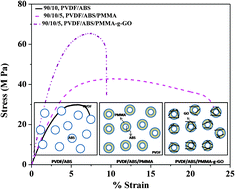Tailoring the interface of an immiscible polymer blend by a mutually miscible homopolymer grafted onto graphene oxide: outstanding mechanical properties
Abstract
A unique strategy was adopted here to improve the compatibility between the components of an immiscible polymer blend and strengthen the interface. PMMA, a mutually miscible polymer to both PVDF and ABS, improved the compatibility between the phases by localizing at the blends interface. This was supported by the core–shell formation with PMMA as the shell and ABS as the core as observed from the SEM micrographs. This phenomenon was strongly contingent on the concentration of PMMA in the blends. This strategy was further extended to localize graphene oxide (GO) sheets at the blends interface by chemically coupling it to PMMA (PMMA-g-GO). A dramatic increment of ca. 84% in the Young's modulus and ca. 124% in the yield strength was observed in the presence of PMMA-g-GO with respect to the neat blends. A simultaneous increment in both the strength and the modulus was observed in the presence of PMMA-g-GO whereas, only addition of GO resulted in a moderate improvement in the yield strength. This study reveals that a mutually miscible polymer can render compatibility between the immiscible pair and can improve the stress transfer at the interface.



 Please wait while we load your content...
Please wait while we load your content...